The document discusses lexical analysis and lexical analyzer generators. It covers topics such as:
- Lexical analysis separates the compiler into distinct phases for simpler design and more efficient implementation.
- Lexical analyzers are specified using regular expressions which are translated into nondeterministic finite automata (NFA) and then deterministic finite automata (DFA) for efficient scanning.
- Tools like Lex and Flex can automatically generate a lexical analyzer in C from a specification file defining tokens with regular expressions and actions.
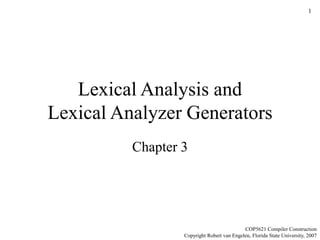


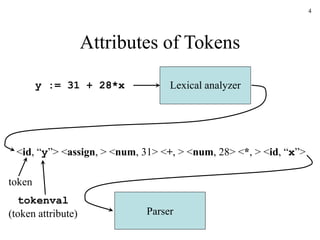


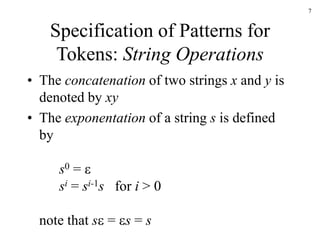




![12
Specification of Patterns for
Tokens: Notational Shorthand
• The following shorthands are often used:
r+ = rr*
r? = r
[a-z] = abc…z
• Examples:
digit [0-9]
num digit+ (. digit+)? ( E (+-)? digit+ )?](https://image.slidesharecdn.com/ch3-220730141926-480785c4/85/Ch3-ppt-12-320.jpg)

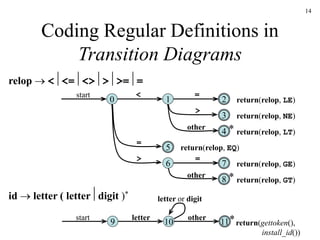
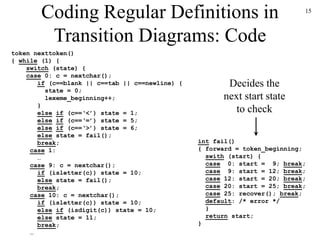



![19
Regular Expressions in Lex
x match the character x
. match the character .
“string”match contents of string of characters
. match any character except newline
^ match beginning of a line
$ match the end of a line
[xyz] match one character x, y, or z (use to escape -)
[^xyz]match any character except x, y, and z
[a-z] match one of a to z
r* closure (match zero or more occurrences)
r+ positive closure (match one or more occurrences)
r? optional (match zero or one occurrence)
r1r2 match r1 then r2 (concatenation)
r1|r2 match r1 or r2 (union)
( r ) grouping
r1r2 match r1 when followed by r2
{d} match the regular expression defined by d](https://image.slidesharecdn.com/ch3-220730141926-480785c4/85/Ch3-ppt-19-320.jpg)
![20
Example Lex Specification 1
%{
#include <stdio.h>
%}
%%
[0-9]+ { printf(“%sn”, yytext); }
.|n { }
%%
main()
{ yylex();
}
Contains
the matching
lexeme
Invokes
the lexical
analyzer
lex spec.l
gcc lex.yy.c -ll
./a.out < spec.l
Translation
rules](https://image.slidesharecdn.com/ch3-220730141926-480785c4/85/Ch3-ppt-20-320.jpg)
![21
Example Lex Specification 2
%{
#include <stdio.h>
int ch = 0, wd = 0, nl = 0;
%}
delim [ t]+
%%
n { ch++; wd++; nl++; }
^{delim} { ch+=yyleng; }
{delim} { ch+=yyleng; wd++; }
. { ch++; }
%%
main()
{ yylex();
printf("%8d%8d%8dn", nl, wd, ch);
}
Regular
definition
Translation
rules](https://image.slidesharecdn.com/ch3-220730141926-480785c4/85/Ch3-ppt-21-320.jpg)
![22
Example Lex Specification 3
%{
#include <stdio.h>
%}
digit [0-9]
letter [A-Za-z]
id {letter}({letter}|{digit})*
%%
{digit}+ { printf(“number: %sn”, yytext); }
{id} { printf(“ident: %sn”, yytext); }
. { printf(“other: %sn”, yytext); }
%%
main()
{ yylex();
}
Regular
definitions
Translation
rules](https://image.slidesharecdn.com/ch3-220730141926-480785c4/85/Ch3-ppt-22-320.jpg)
![23
Example Lex Specification 4
%{ /* definitions of manifest constants */
#define LT (256)
…
%}
delim [ tn]
ws {delim}+
letter [A-Za-z]
digit [0-9]
id {letter}({letter}|{digit})*
number {digit}+(.{digit}+)?(E[+-]?{digit}+)?
%%
{ws} { }
if {return IF;}
then {return THEN;}
else {return ELSE;}
{id} {yylval = install_id(); return ID;}
{number} {yylval = install_num(); return NUMBER;}
“<“ {yylval = LT; return RELOP;}
“<=“ {yylval = LE; return RELOP;}
“=“ {yylval = EQ; return RELOP;}
“<>“ {yylval = NE; return RELOP;}
“>“ {yylval = GT; return RELOP;}
“>=“ {yylval = GE; return RELOP;}
%%
int install_id()
…
Return
token to
parser
Token
attribute
Install yytext as
identifier in symbol table](https://image.slidesharecdn.com/ch3-220730141926-480785c4/85/Ch3-ppt-23-320.jpg)















![39
The Subset Construction
Algorithm
Initially, -closure(s0) is the only state in Dstates and it is unmarked
while there is an unmarked state T in Dstates do
mark T
for each input symbol a do
U := -closure(move(T,a))
if U is not in Dstates then
add U as an unmarked state to Dstates
end if
Dtran[T,a] := U
end do
end do](https://image.slidesharecdn.com/ch3-220730141926-480785c4/85/Ch3-ppt-39-320.jpg)

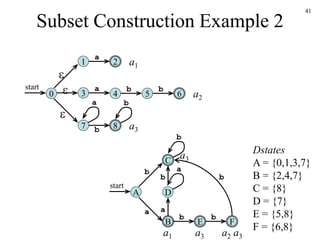
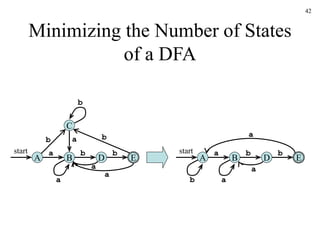
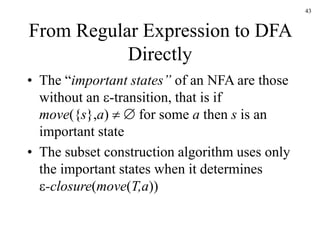
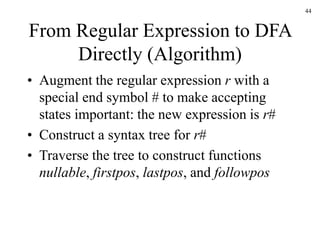


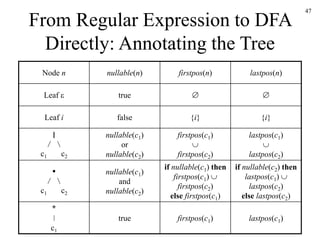


![50
From Regular Expression to DFA
Directly: Algorithm
s0 := firstpos(root) where root is the root of the syntax tree
Dstates := {s0} and is unmarked
while there is an unmarked state T in Dstates do
mark T
for each input symbol a do
let U be the set of positions that are in followpos(p)
for some position p in T,
such that the symbol at position p is a
if U is not empty and not in Dstates then
add U as an unmarked state to Dstates
end if
Dtran[T,a] := U
end do
end do](https://image.slidesharecdn.com/ch3-220730141926-480785c4/85/Ch3-ppt-50-320.jpg)

